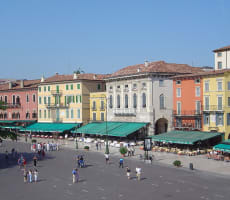

Things To Do in Verona, Italy
Verona, Italy, is a city steeped in history and adorned with captivating historical sites. From ancient Roman ruins to medieval castles, Verona offers a rich tapestry of architectural wonders and cultural heritage. Exploring this enchanting city, visitors can delve into the past and witness the echoes of bygone eras. The well-preserved Roman amphitheater, majestic palaces, and ornate churches serve as testaments to Verona's historical significance. Walking through the winding cobblestone streets, one can imagine the grandeur of the past, as each corner reveals a story waiting to be discovered. Whether you are an avid history enthusiast or simply seeking to immerse yourself in the city's timeless charm, Verona's historical sites promise a remarkable journey through time.
For more travel recommendations, check my Socials through these links:

Church of Saint Anastasia
In Verona, the largest church is Santa Anastasia, distinguished by its unfinished facade. Its construction commenced in 1290 and continued for more than two centuries. The Church of Santa Anastasia is renowned for its abundant collection of artworks, showcasing its grandeur as a splendid representation of Gothic art in Italy.
- Piazza S.Anastasia
- Church/Basilica

Ponte Pietra
This spot has always played a vital role in communication and trade, which is why Verona was founded here. The original city was established on the hill of Saint Peter, just above where we are now. Later, the Romans crossed the river and built the new city on the opposite side, resulting in Ponte Pietra bridge not aligning with the layout of the ancient Roman streets. Remarkably, this bridge has survived for over two thousand years, dating back to the first century BC, despite enduring numerous floods throughout the centuries. It has been restored, with the Roman part visible behind me and the medieval section marked by the tower. Locals still recall that Ponte Pietra did not withstand the German bombs at the end of World War II in 1945.
- Verona
- Historical

Castle of San Pietro
The Castle of San Pietro offers a vantage point to behold one of Verona's most magnificent landscapes. However, it is important to note that the Castle of San Pietro is not a castle per se, but rather a military barracks constructed by the Austrians in the 19th century. It was built upon the site of a previous castle erected by Gian Galeazzo Visconti at the end of the 14th century, which was later destroyed by Napoleon.
- San Pietro
- Historical

Walls of Verona
The walls of Verona stretch for approximately six miles, making it impractical to explore them on foot. Instead, it is much more enjoyable to traverse them by bike. The walls ascend uphill, adding to their scenic charm. The oldest segment of this expansive defensive structure follows the ridge of the hills surrounding the northern part of the city, known as Leto Richelde. This area offers well-maintained paths for hiking and trails ideal for mountain biking.
- Verona
- Historical

St Georges Bastion
Professor Mauricio D'Alessandro, the leader of the volunteer group facilitating the visits, guided me through the depths of the bastion. The Austrian bastion of St. George was strategically positioned to safeguard the postal road to the Tyrol, which passed through the Trento Gate, commonly known as the St. George Gate. Its purpose was threefold: defending the city from river-based adversaries, fortifying the network of fortresses on the hills surrounding Verona to deter attacks, and serving as the last link in the fortified chain stretching from the northeastern to the northwestern hills of Verona.
- Lungadige S. Giorgio
- Historical

Castelvecchio
Continuing my journey, I cross the mighty pedestrian bridge of Castelvecchio, which was originally built in the 14th century, destroyed by the Germans in 1945, and reconstructed in 1951 using salvaged original stones and bricks from the river. I proceed to visit the Castlevacio Museum, one of Verona's most important museums, located within the castle's halls. The museum houses significant collections of medieval, Renaissance, and modern art, including paintings, sculptures, weapons, drawings, and prints. There is also a dedicated space for temporary exhibits.
- Verona
- Historical

Guisti Garden
Across the Adige River lies a hidden and enchanting place, the Juicy Garden, accompanied by the palace that once belonged to the Juicy family. This garden, created in the late 15th century, offers a captivating experience with its seven rooms furnished in the early 1900s style, which are open for visitors to explore.
Over the centuries, the Juicy Garden has welcomed numerous distinguished personalities. With its terraces strategically designed, visitors can gradually discover breathtaking views of the city. The garden, styled in the 1500s fashion, features all that was fashionable at the time, including citrus trees, mythological statues, caves, Roman remains, and pavilions, all intended to enhance the scenic vistas.
- Via Giardino Giusti
- Historical

Piazza Bra
I took a leisurely walk along Matinee Street, which is known as Verona's vibrant shopping district. Eventually, I arrive at Bra Square, a grand expanse that proudly claims the title of Verona's largest square and one of Europe's largest.
- Piazza Bra
- Recreational

Arena of Verona
The Verona Arena is an impressive structure, spanning 400 feet by 500 feet and standing 100 feet tall. It holds the distinction of being the fourth largest Roman amphitheater in Italy. Although it was originally much larger, with only a small section called the "wing" remaining from the collapsed third gallery. During the Roman era, the arena could accommodate up to 30,000 spectators who gathered to witness the shows held on the sandy arena floor, known as "sabia" in Italian.
- Piazza Bra
- Historical